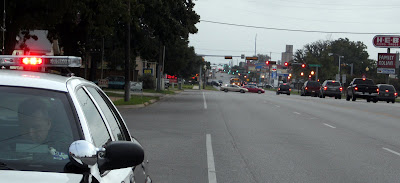Congratulations to the City of Austin - on Thursday, October 22, 2009,
Austin became the first city in the State of Texas to adopt a Safe Passing
ordinance! This means that Safe Passing will now be the law of the land in
Austin, TX.
Thanks to the Austin City Council, especially Mayor Lee Leffingwell and
Councilmembers Mike Martinez and Chris Riley, and city staff for working with
BikeTexas to make this a reality.
This is a major step, but it is only the beginning. BikeTexas intends to
work hard to duplicate this success in cities and towns all over the state
before the next legislative session.
So trumpets the Texas Bicycle Coalition. (TBC) With such wonderful successes, TBC is in danger of becoming irrelevant, because what they define as a success looks exactly the same as what went on before!
I know it is fashionable lately to pass laws without reading the actual text of the legislation, but words do matter. The devil, they say, is in the details.
Into the weeds
The city ordinance reads:
PART 1. Section 12-1-35 of the City Code is amended to read:
§ 12-1-35 VULNERABLE ROAD USERS.
In this section, a Vulnerable Road User means:
a pedestrian, including a runner, physically disabled person, child, skater, highway construction and maintenance worker, tow truck operator, utility worker, other worker with legitimate business in or near the road or right-of-way, or stranded motorist or passenger;
(2) a person on horseback;
(3) a person operating equipment other than a motor vehicle, including, but not limited to, a bicycle, handcycle, horse-driven conveyance, or unprotected farm equipment; or
(4) a person operating a motorcycle, moped, motor-driven cycle, or motor-assisted scooter.
An operator of a motor vehicle passing a vulnerable road user operating on a highway or street shall:
(1) vacate the lane in which the vulnerable road user is located if the highway has two or more marked lanes running in the same direction; or
(2) pass the vulnerable road user at a safe distance.
(c) For the purpose of Subsection (b)(2), when road conditions allow, safe distance is at least:
(1) three feet if the operator’s vehicle is a passenger car or light truck; or
(2) six feet if the operator’s vehicle is a truck, other than a light truck, or a commercial motor vehicle as defined by Texas Transportation Code Section 522.003.
(d) An operator of a motor vehicle that is making a left turn at an intersection, including an intersection with an alley or private road or driveway, shall yield the right-of-way to a vulnerable road user who is approaching from the opposite direction and is in the intersection, or is in such proximity to the intersection as to be an immediate hazard.
(e) An operator of a motor vehicle may not overtake a vulnerable road user traveling in the same direction and subsequently make a right-hand turn in front of the vulnerable road user unless the operator is safely clear of the vulnerable road user, taking into account the speed at which the vulnerable road user is traveling and the braking requirements of the motor vehicle making the right-hand turn.
(f) An operator of a motor vehicle may not maneuver the vehicle in a manner that:
(1) is intended to cause intimidation or harassment to a vulnerable road user; or
(2) threatens a vulnerable road user.
(g) An operator of a motor vehicle shall exercise due care to avoid colliding with any vulnerable road user on a roadway or in an intersection of roadways.
(h) It is an affirmative defense to prosecution under this section that at the time of the offense the vulnerable road user was acting in violation of the law.
Well, it could've been worse! They could've repeated every section of the Texas Transportation Code! (TTC) They relented and only repeated some of them.
Even deeper into the weeds- comparing the new to the old
(b)(1) An operator of a motor vehicle passing a vulnerable road user operating on a highway or street shall: (1) vacate the lane in which the vulnerable road user is located if the highway has two or more marked lanes running in the same direction.
This is covered in the TTC by Sec. 545.060. (a) An operator on a roadway divided into two or more clearly marked lanes for traffic: shall drive as nearly as practical entirely within a single lane; and (2) may not move from the lane unless that movement can be made safely. and by Sec. 545.351. (b)(2) An operator shall control the speed of the vehicle as necessary to avoid colliding with another person or vehicle that is on or entering the highway in compliance with law and the duty of each person to use due care.
(b)(2)An operator of a motor vehicle passing a vulnerable road user operating on a highway or street shall: pass the vulnerable road user at a safe distance.
This is amply covered in the TTC this way: Sec. 545.053. (a) An operator passing another vehicle: (1) shall pass to the left of the other vehicle at a safe distance; and (2) may not move back to the right side of the roadway until safely clear of the passed vehicle.
(d) An operator of a motor vehicle that is making a left turn at an intersection, including an intersection with an alley or private road or driveway, shall yield the right-of-way to a vulnerable road user who is approaching from the opposite direction and is in the intersection, or is in such proximity to the intersection as to be an immediate hazard.
How is this any different from the TTC? From Sec. 545.152. To turn left at an intersection or into an alley or private road or driveway, an operator shall yield the right-of-way to a vehicle that is approaching from the opposite direction and that is in the intersection or in such proximity to the intersection as to be an immediate hazard.
Oh, it changes the word "vehicle" to vulnerable road user. But bicycles ARE vehicles in the TTC, [*] and it is a violation of the TTC to strike pedestrians on the roadway as seen in 545.351. (b)(2) above.
(e) An operator of a motor vehicle may not overtake a vulnerable road user traveling in the same direction and subsequently make a right-hand turn in front of the vulnerable road user unless the operator is safely clear of the vulnerable road user, taking into account the speed at which the vulnerable road user is traveling and the braking requirements of the motor vehicle making the right-hand turn.
This provision, besides being overly wordy, is also redundant. Sec. 545.103. An operator may not turn the vehicle to enter a private road or driveway, otherwise turn the vehicle from a direct course, or move right or left on a roadway unless movement can be made safely. The biggest difference is that Austin's law applies exclusively to motor vehicles, but the TTC applies to all vehicles. Is that really a difference that matters?
(f) An operator of a motor vehicle may not maneuver the vehicle in a manner that: (1) is intended to cause intimidation or harassment to a vulnerable road user; or (2) threatens a vulnerable road user.
I am glad that these behaviors are now prohibited in Austin! But if they were already illegal, why was this language included in the ordinance? Does this give license to pedestrians and roller-skaters to intimidate or harass others? Or are motorists the only citizens in Austin that are restricted from being a bully?
(g) An operator of a motor vehicle shall exercise due care to avoid colliding with any vulnerable road user on a roadway or in an intersection of roadways.
As before, Sec. 545.351. (b)(2)
What to make of all this
All of these provisions found in the TTC are available to protect cyclists in every city in Texas right now. The question really is, in the light of the above comparisons, why are our advocates spending time, energy and treasure in passing laws that mirror those already present but are not being enforced? Is this really the path to better cycling conditions on Texas roads?
So if the TBC is doing what is obviously not going to do anything meaningful for Texas cyclists, why are they doing it? Who benefits? Aside from TBC doing make-work and calling it a "major step" in order to spice up their fund-raising literature, what have they achieved of lasting benefit for Austin cyclists? I accuse the TBC of doing nothing of substance for those they claim to represent with such useless laws.
We need better advocates.
We need advocates that demand that the traffic laws already on the books be enforced by local police before writing and passing redundant legislation.
We need advocates that demand local district attorneys uphold all of the laws, as is their duty.
We need advocates that demand judges follow the law, as is also their sworn duty.
We need advocates that will work for cyclist's equality under the law. Now that Austin cyclist's ability to recover damages is contingent on their ability to demonstrate they were operating lawfully, (Paragraph h) will the TBC work to have bicycle traffic laws enforced too? Or does the TBC have no more responsibility for their actions once the laws they shepherd through legislative bodies are passed?
We need advocates that are willing to do the hard work of building broad-based and inclusive coalitions to change our social acceptance of inattentive driving. We are all stake-holders in a more civil public road, even if we are automobile drivers only. Besides the obvious economic benefits of fewer wrecks as expressed in property damage, broken bodies and broken lives, there would be more resources available for progress rather than just cleaning up the mess. Car insurance costs would decline. Less treasure and talent used in emergency rooms patching up the injured can mean more resources available for the sick. More faces around the dinner table.
We need bicycle advocates that address the root problem. We need advocates that can dream big dreams. We need advocates who understand that our streets are for people- all the people- and see that making our streets better for all of us make it better for cyclists too.
We need advocates who want to do big things. To make changes that will matter.
The Texas Bicycle Coalition thinks this new ordinance in Austin is a major step.
How pitiful our advocates are!
*The TTC defines a bicycle as: Sec. 541.201. (2) "Bicycle" means a device that a person may ride and that is propelled by human power and has two tandem wheels at least one of which is more than 14 inches in diameter.
This is a subset of the larger category of "vehicle: Sec. 541.201. (23) "Vehicle" means a device that can be used to transport or draw persons or property on a highway.









































